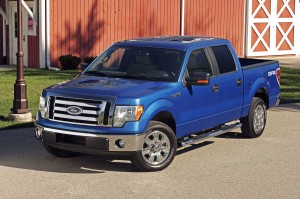
Buyers continue to go for pickups and SUVs - albeit with high-tech engines that can deliver better mileage.
When gas prices first hit $2.50 a gallon, auto industry planners braced for a dramatic shift in the market. It didn’t happen. When the pump price first nudged $4, back in the summer of 2008, environmentalists rejoiced, betting that hybrids would replace pickups and SUVs as the vehicles of choice. Yet after a month or so, most U.S. motorists went right back to the cars and trucks they long preferred.
This year’s run-up in fuel costs has once again led many to anticipate a wholesale shift in demand and indeed, sales of small cars have been gaining ground – but pickups, SUVs, crossovers and muscle cars haven’t exactly vanished from the sales charts – a new study by AutoPacific, Inc. suggesting that despite wishful thinking, Americans have largely grown immune to high fuel prices.
The consulting firm’s latest Fuel Price Impact Survey concludes that while, “American drivers complain about near historically high fuel prices…few are doing much about it. In fact, choice of what vehicle to buy in the future appears to have decoupled from the price of fuel.”
Until the current economic meltdown sent petro-traders into a panic, gas prices this year have been averaging a full dollar more than a year ago. But the study finds that there has been little shift in what motorists are driving and, with rare exception, there have been few changes in the type of engines American car buyers are opting for.
That’s not to say Americans are completely oblivious to the cost of fuel; if anything, they are changing the way they drive, 41% of the motorists AutoPacific surveyed saying they have been combining trips to reduce fuel consumption. That reflects government and industry data showing that the number of mileage U.S. motorists clock each month has been steadily declining.
The situation does provide an opportunity for aftermarket vendors offering ways to improve a vehicle’s mileage – one in 10 respondents saying they will add a fuel-saving device in the coming months. But that may simply make motorists vulnerable to scams, various consumer authorities – and the federal EPA – warning that, for the most part, there’s no way to improve a car’s mileage other than keeping it tuned and making sure its tires are properly inflated.
Even though fuel costs have skyrocketed over the last year, 25% of buyers say they still want an SUV, while 14% are looking at a pickup. By comparison, only 16% told AutoPacific they’re looking at a small car.
If anything is changing it’s the availability of new powertrain options, using turbocharging, for example, to deliver both more power and improved mileage without downsizing.
Hybrids may generate headlines, however, they have not become the mainstream choice many makers anticipated. During a similar survey in July 2008 – when U.S. gas prices peaked at around $4.17 a gallon – a full 25% of motorists gave at least some consideration to a gas-electric model. That’s now down to 10%, according to AutoPacific. And when it comes to actually buying a vehicle, hybrids currently make up barely 3% of overall U.S. market demand.
That suggests that what buyers say they want doesn’t always correspond to what they wind up buying. About a quarter of all respondents said they want a four-cylinder engine in their next vehicle, the same as in July 2010. Meanwhile, interest in the classic V-8 has dipped only slightly, from 17% to 15% over the last year.
In the market, V-8 sales have tumbled sharply in recent years from 29%, six years ago to just 18% in recent months – but that’s still more than the new AutoPacific study would suggest based on what buyers say they are looking for.
